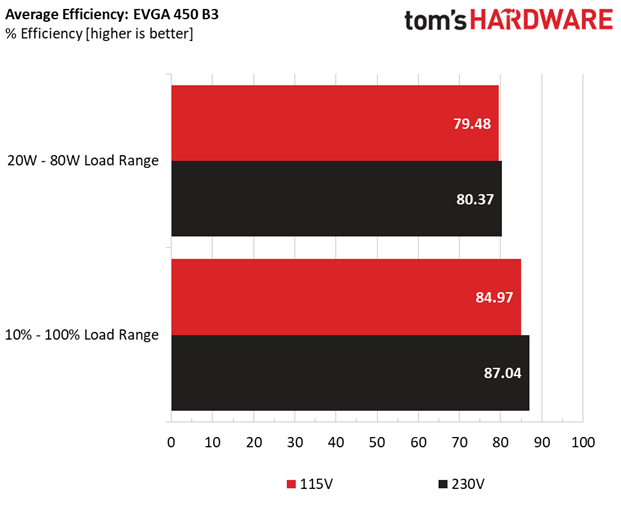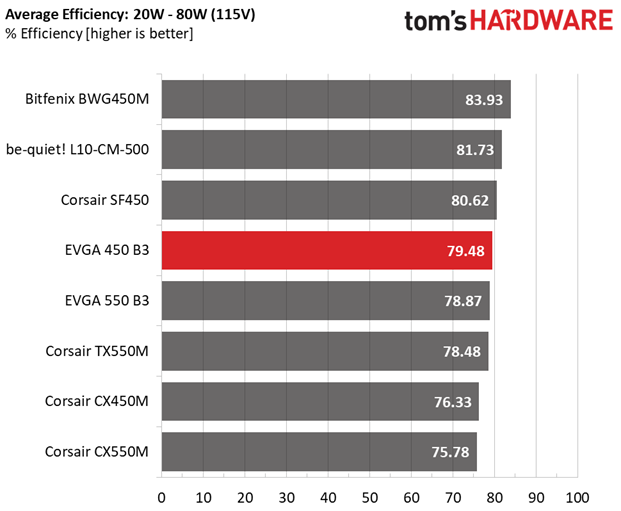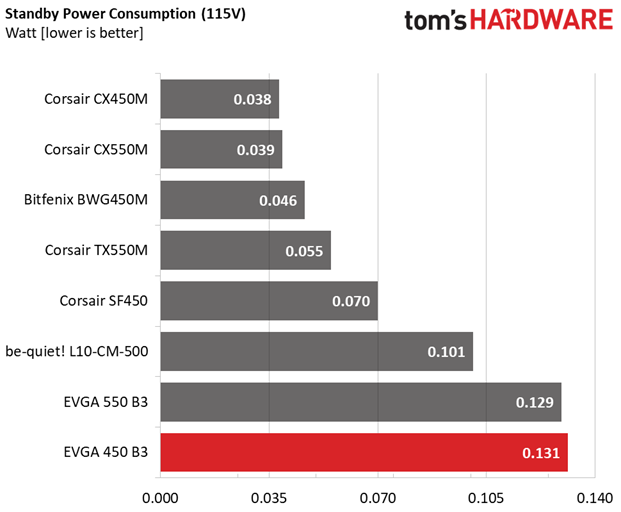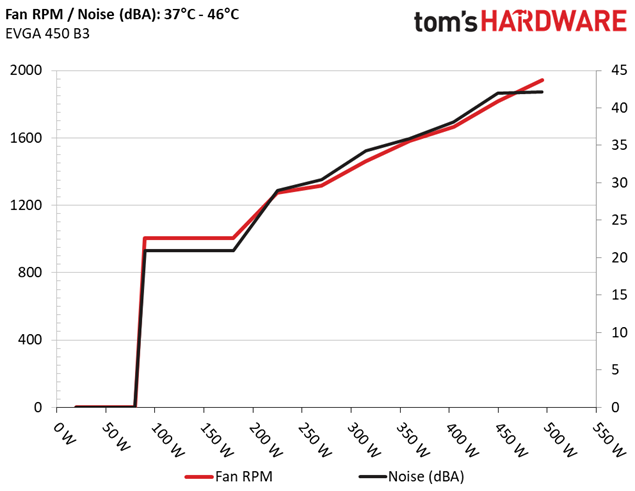EVGA 450 B3 PSU Review
Why you can trust Tom's Hardware
Efficiency, Temperature & Noise
Efficiency
Our efficiency testing procedure is detailed here.
Using results from the previous page, we plotted a chart showing the 450 B3's efficiency at low loads, and loads from 10 to 110 percent of its maximum-rated capacity.




EVGA's 450 B3 takes the lead in efficiency from its main competitor, Corsair's CX450M. The differences aren't large under normal loads, but light loads make the gap more notable.
Efficiency At Low Loads
In the following tests, we measure the 450 B3's efficiency at loads significantly lower than 10 percent of its maximum capacity (the lowest load the 80 PLUS standard measures). The loads we dialed were 20, 40, 60, and 80W. This is important for representing when a PC is idle, with power-saving features turned on.
| Test # | 12V | 5V | 3.3V | 5VSB | DC/AC (Watts) | Efficiency | Fan Speed | Fan Noise | PF/AC Volts |
|---|---|---|---|---|---|---|---|---|---|
| 1 | 1.194A | 0.493A | 0.477A | 0.191A | 19.626 | 69.527% | 0 RPM | <6.0 dB(A) | 0.770 |
| 12.204V | 5.045V | 3.324V | 5.135V | 28.228 | 115.18V | ||||
| 2 | 2.415A | 0.992A | 0.990A | 0.391A | 39.755 | 80.129% | 0 RPM | <6.0 dB(A) | 0.895 |
| 12.199V | 5.042V | 3.323V | 5.123V | 49.614 | 115.18V | ||||
| 3 | 3.643A | 1.477A | 1.503A | 5.111A | 59.843 | 82.694% | 0 RPM | <6.0 dB(A) | 0.941 |
| 12.193V | 5.039V | 3.321V | 5.111V | 72.367 | 115.18V | ||||
| 4 | 4.858A | 1.986A | 1.983A | 0.781A | 79.786 | 85.571% | 0 RPM | <6.0 dB(A) | 0.967 |
| 12.190V | 5.036V | 3.320V | 5.099V | 93.239 | 115.18V |
With 20W load, efficiency drops below 70%. However, it passes the 80% mark under higher loads. These are good results for a budget-oriented PSU.
5VSB Efficiency
The ATX specification, along with CEC, ErP Lot 3 2014 and ErP Lot 6 2010/2013, states that 5VSB standby supply efficiency should be as high as possible, recommending 75 percent or higher with 550mA, 1A, and 1.5A of load. The PSU should also achieve higher than 75% efficiency at 5VSB under full load, or with 3A if its max current output on this rail is higher than 3A.
We take six measurements: one each at 100, 250, 550, 1000, and 1500mA, and one with the full load the 5VSB rail can handle.
Get Tom's Hardware's best news and in-depth reviews, straight to your inbox.
| Test # | 5VSB | DC/AC (Watts) | Efficiency | PF/AC Volts |
|---|---|---|---|---|
| 1 | 0.101A | 0.521 | 66.709% | 0.056 |
| 5.143V | 0.781 | 115.11V | ||
| 2 | 0.251A | 1.292 | 73.493% | 0.120 |
| 5.137V | 1.758 | 115.11V | ||
| 3 | 0.542A | 2.777 | 76.145% | 0.214 |
| 5.126V | 3.647 | 115.13V | ||
| 4 | 1.002A | 5.118 | 77.463% | 0.300 |
| 5.109V | 6.607 | 115.14V | ||
| 5 | 1.502A | 7.643 | 77.720% | 0.350 |
| 5.090V | 9.834 | 115.15V | ||
| 6 | 3.001A | 15.085 | 76.218% | 0.417 |
| 5.026V | 19.792 | 115.15V |


This PSU manages to meet the CEC, ErP Lot 3 2014 and ErP Lot 6 2013 requirements with 115V input. Efficiency is notably lower on this rail with 230V input though, and the CEC requirements are not met.
We have evaluated a great many Super Flower platforms, and it's painfully clear that the manufacturer uses an outdated 5VSB circuit in all of its designs. SF should upgrade this rail as soon as possible in order to satisfy all current requirements and directives with both voltage inputs (115V and 230V).
Power Consumption In Idle And Standby
In the table below, you'll find the power consumption and voltage values of all rails (except -12V) when the PSU is idle (powered on, but without any load on its rails), and the power consumption when the PSU is in standby mode (without any load, at 5VSB).
| Mode | 12V | 5V | 3.3V | 5VSB | Watts | PF/AC Volts |
|---|---|---|---|---|---|---|
| Idle | 12.216V | 5.047V | 3.327V | 5.145V | 6.363 | 0.318 |
| 115.2V | ||||||
| Standby | 0.131 | 0.010 | ||||
| 115.1V |


The vampire power that our equipment measured is much higher compared to other, similar-capacity PSUs.
Fan RPM, Delta Temperature, And Output Noise
Our mixed noise testing is described in detail here.
The chart below illustrates the cooling fan's speed (in RPM), and the delta between input and output temperature. The results were obtained at 37°C (98.6°F) to 46°C (114.8°F) ambient temperature.
The next chart shows the cooling fan's speed (again, in RPM) and output noise. We measured acoustics from one meter away, inside a hemi-anechoic chamber. Background noise inside the chamber was below 6 dB(A) during testing (it's actually much lower, but our sound meter’s microphone hits its floor), and the results were obtained with the PSU operating at 37°C (98.6°F) to 46°C (114.8°F) ambient temperature.
The following graph illustrates the fan's output noise over the PSU's operating range. The same conditions of the above graph apply to our measurements, though the ambient temperature was between at 30°C (86°F) to 32°C (89.6°F).
The semi-passive mode lasts a long time for such an inefficient PSU. No doubt, it helps that we're only dealing with 450W of capacity. Once the load goes over 240W at +12V, fan noise exceeds 30 dB(A). There is also a small region where our measurements indicate between 35-40 dB(A).
MORE: Best Power Supplies
MORE: How We Test Power Supplies
MORE: All Power Supply Content
Current page: Efficiency, Temperature & Noise
Prev Page Load Regulation, Hold-Up Time & Inrush Current Next Page Protection Features & The OPP Flaw
Aris Mpitziopoulos is a contributing editor at Tom's Hardware, covering PSUs.


